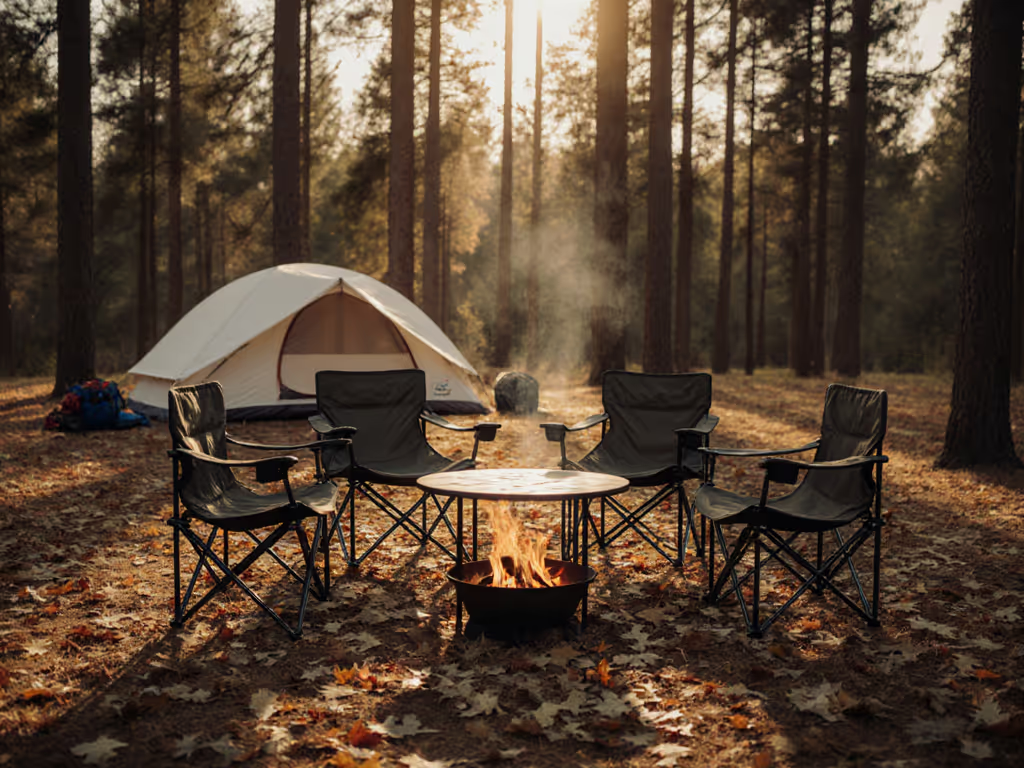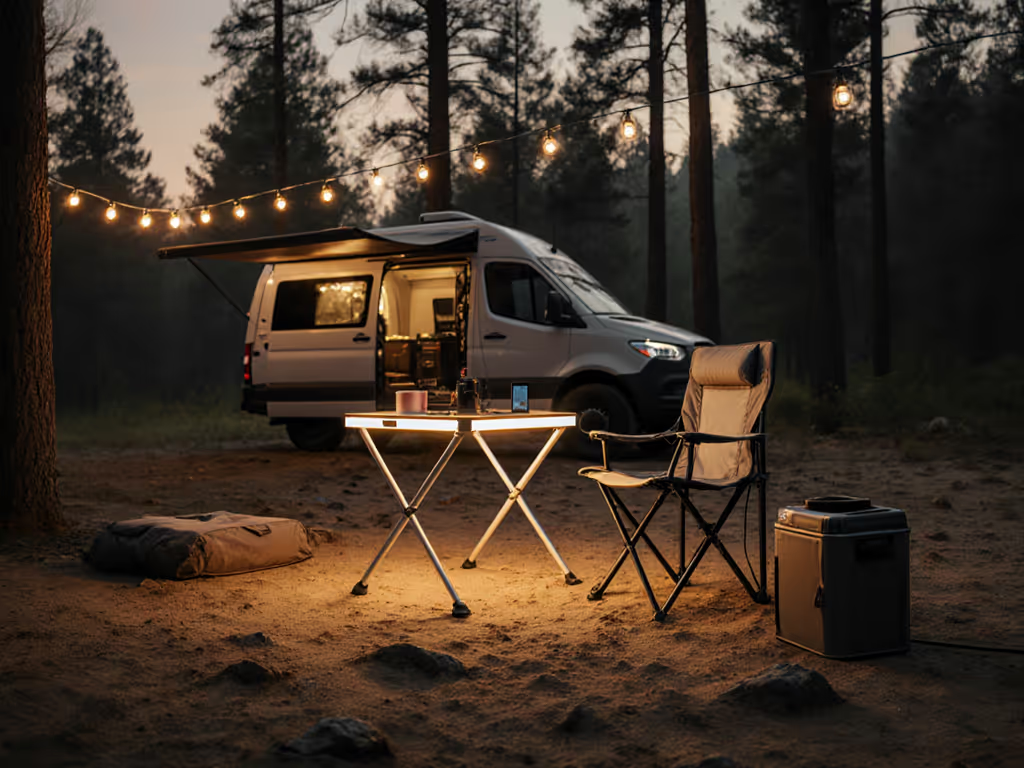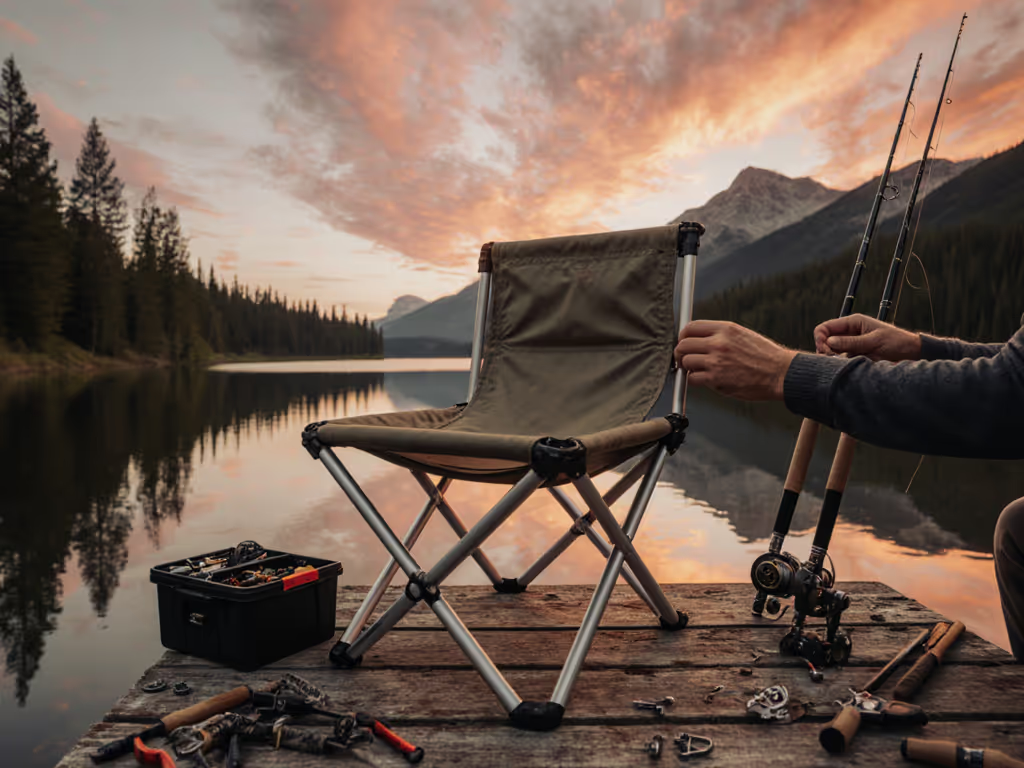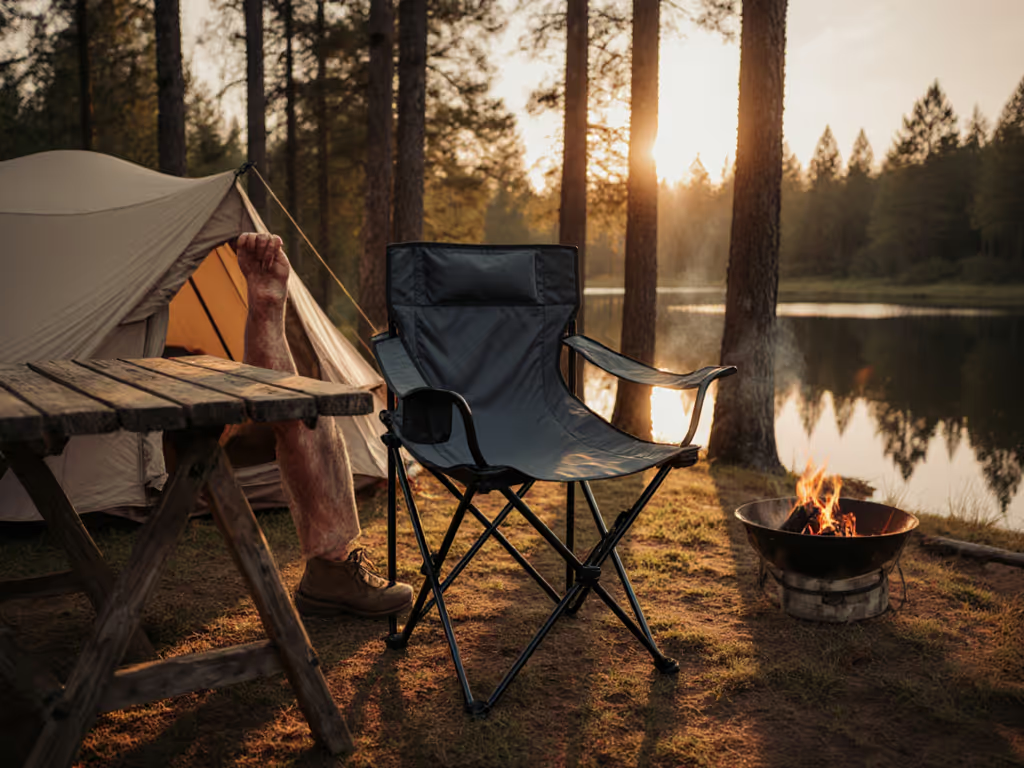
How to Choose the Right Camping Chair and Table: The Data-Driven Checklist for Perfect Camp Comfort

You came for clear answers on how to choose the right camping chair and table, and you will leave with a practical, data-driven plan. If you have ever juggled a plate on your knees or leaned awkwardly to reach a low table, you already know the real problem: mismatched gear kills comfort. The fix is not just buying a cushier seat. It is matching seat height, table height, angles, and stability so your camp setup feels like home, even when you are a hundred miles from it.
That is exactly where Camper Loadouts steps in. Camper Loadouts provides curated guides, reviews, and pairing recommendations that match chairs, tables, cots, and organizers through measured seat-to-table geometry, pack volume, setup time, and stability. Instead of guessing, you get proven pairings for outdoor enthusiasts, glampers, car campers, and anglers. Ready to make every bite steady and every hour by the fire genuinely comfortable? Start with our camp chair geometry guide to dial in seat angles, armrest height, and knee-to-hip fit.
Why Fit Beats Features: The Geometry Behind Camp Comfort
Before comparing fabrics or cup holders, start with geometry. Your knees, hips, and elbows need friendly angles to rest, eat, and relax without strain. For standard eating, most campers are comfiest when their elbow angle sits near 90 to 110 degrees and their knees near 90 to 100 degrees. That means the table should be about the same height as your elbows when you are seated, and your seat should let your feet plant firmly. When those two measurements line up, your posture relaxes and food stops wobbling.
So what numbers should you aim for? For a typical adult, a standard dining-style camp table height of 28 to 30 inches (71 to 76 centimeters) pairs well with a chair seat height of 17 to 19 inches (43 to 48 centimeters). For table height fine-tuning and adjustability tips, see our ergonomic camping tables guide. For low camp lounging or beach setups, a 16 to 20 inch (41 to 51 centimeters) low table often pairs best with a 10 to 13 inch (25 to 33 centimeters) seat height. For glamping lounges, reclining backs around 100 to 110 degrees reduce back pressure, while armrests at about 9 to 10 inches (23 to 25 centimeters) above the seat help you stand smoothly.
Anglers and bank fishers face a twist: low seating near water improves stability and rod control, but it demands a shorter side table for tackle and snacks. Add wide feet to prevent sinking into sand or mud and a table with adjustable legs for uneven riverbanks. Camper Loadouts produces comparative analyses and reviews that can include angler-relevant factors such as base width, stability, and quick-drying fabrics, so you can sit low, stay dry, and keep your gear at hand without stooping.
| Use Case | Recommended Seat Height | Recommended Table Height | Target Elbow Angle | Notes |
|---|---|---|---|---|
| Dining at camp | 17 to 19 inches (43 to 48 centimeters) | 28 to 30 inches (71 to 76 centimeters) | 90 to 110 degrees | Most stable for meals and board games |
| Low lounge / beach | 10 to 13 inches (25 to 33 centimeters) | 16 to 20 inches (41 to 51 centimeters) | 95 to 110 degrees | Encourages relaxed posture near the fire |
| Fishing bank setup | 11 to 15 inches (28 to 38 centimeters) | 18 to 24 inches (46 to 61 centimeters) | 90 to 105 degrees | Add wide feet and adjustable table legs |
| Glamping lounge | 16 to 18 inches (41 to 46 centimeters) | 22 to 26 inches (56 to 66 centimeters) | 100 to 110 degrees | Reclining back plus side table height for drinks |
How to Choose the Right Camping Chair and Table: The Data-Driven Checklist
Want a simple, repeatable method? Use this numbered checklist to translate human measurements and terrain into a comfortable, stable, and packable setup. It works for families, solo car campers, glamping couples, and anglers who demand function near the water. Take five minutes to measure, then shop smarter once for years of comfort. Keep a small tape and notepad in your glove box so you can reference these numbers anywhere.
Watch This Helpful Video
To help you better understand how to choose the right camping chair and table, we've included this informative video from BuildersSA. It provides valuable insights and visual demonstrations that complement the written content.
- Measure your seated elbow height. Sit on a chair at home. Measure from the seat surface to your bent elbow. That number is your target table height for eating plus or minus 1 inch (2.5 centimeters).
- Measure your popliteal height. That is the floor to the back of your knee when seated. Choose a seat height within 1 inch (2.5 centimeters) of that number for best knee angles and foot contact.
- Define your primary activity. Dining, fireside lounging, or fishing? Dining prefers higher tables. Lounging prefers lower tables. Fishing prefers low seating with side access and wide feet.
- Check table adjustability. Adjustable legs give 2 to 5 inches (5 to 13 centimeters) of wiggle room for slopes and mixed activities. Prioritize adjustment if you camp on uneven terrain.
- Assess stability width. For chairs, look for a base width that is at least 60 percent of seat height for soft surfaces. For tables, wider crossbars or diagonal braces resist side wobble. For wobble-proof picks and lab tests, review our stability-tested folding tables comparison.
- Set comfort duration goals. If you plan to sit 3 hours by the fire, prioritize lumbar support and armrests. If you only snack at the table, weight savings might matter more.
- Score pack volume. Add the chair and table packed sizes in liters. Car campers often prefer a combined pack volume under 80 liters for a two-person set; ultralight pairs can be 30 to 50 liters.
- Time your setup. Aim for under 4 minutes per pair for fast weeknight trips. Families may accept 6 to 8 minutes for larger, modular setups if comfort is superior.
- Verify materials. Aluminum frames save weight and resist rust. Steel adds strength for heavy-duty loads. Fabrics like 600 denier (D) polyester and 3D mesh balance durability and breathability.
- Pair intentionally. Use your measurements to match seat height to table height, then check stability and pack volume. If in doubt, consult Camper Loadouts chair and table pairing guides for verified combos.
With these steps, you make the gear fit your body and your trip, not the other way around. And because you measure once and choose once, you avoid the box of mismatched camp furniture many campers confess to owning. That is better for your back, better for your meals, and better for your trunk space. Still unsure about a tricky terrain or special activity? Camper Loadouts has activity-specific checklists ready to go.
Compare Chair and Table Types by Use Case
Features can distract from fit. This comparison table cuts through the noise by pairing common chair and table types with their best use cases, geometry targets, and terrain notes. Skim for your activity, then adjust heights and widths to match your measurements. A few millimeters may not matter on paper, but a half inch (1.3 centimeters) at your elbow is noticeable in camp. That is why we present ranges and give you room to tune.
| Pair Type | Primary Use | Seat Height | Table Height | Terrain | Comfort Notes |
|---|---|---|---|---|---|
| Director chair + standard roll-top table | Cooking and dining | 18 inches (46 centimeters) | 29 inches (74 centimeters) | Packed dirt, gravel | Upright posture, easy in and out with armrests |
| Low beach chair + compact low table | Fireside lounging | 12 inches (30 centimeters) | 18 inches (46 centimeters) | Sand, soft soil | Relaxed recline; add wide feet to avoid sinking |
| Recliner lounge + side table | Glamping and reading | 16 inches (41 centimeters) | 22 inches (56 centimeters) | Decks, mats, lawn | Back angle 105 to 110 degrees for long sessions |
| Swivel fishing chair + tackle side table | Bank and pier fishing | 14 inches (36 centimeters) | 20 inches (51 centimeters) | Mud, rock, piers | Quick stand-up; gear within forearm reach |
| Ultralight folding chair + aluminum slat table | Minimalist car camping | 16 inches (41 centimeters) | 25 inches (64 centimeters) | Mixed | Low pack volume; mind crosswind stability |
| Heavy-duty padded chair + steel frame table | Family meals and games | 19 inches (48 centimeters) | 30 inches (76 centimeters) | Firm ground | Max weight capacity and wobble resistance |
Notice how each pair keeps elbow and knee angles in a friendly range for the job. The dining pairs push the table higher so your wrists sit level with the tabletop, which reduces shoulder shrugging and fatigue. Lounging pairs drop the table to stop you from overreaching while you recline. Fishing pairs keep a low seat for stability and a mid-height side table for fast, no-look access to gear. The right match makes each activity feel effortless.
Packability, Durability, and Setup Time: The Data That Matters
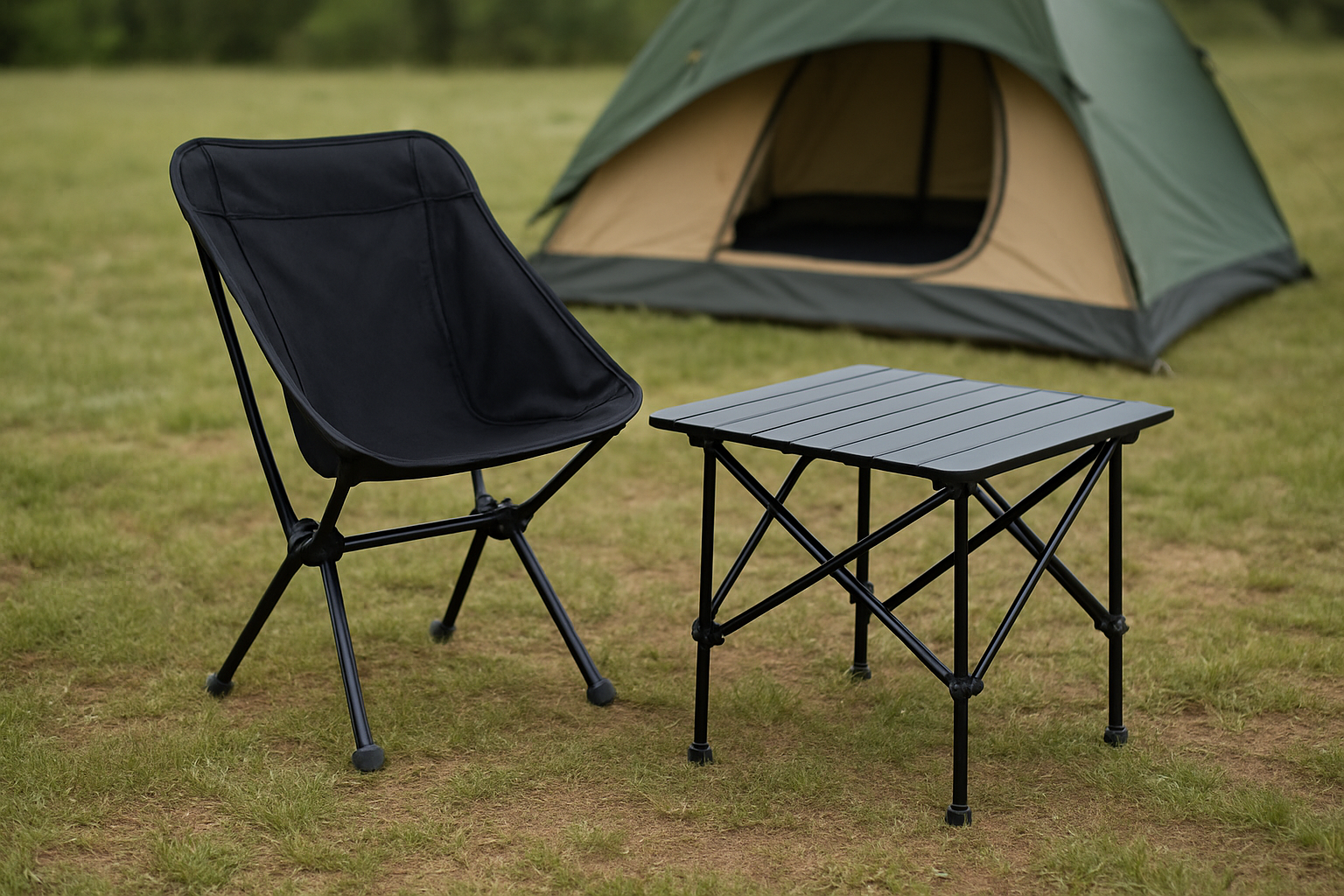
Comfort is king, yet a cramped trunk or tedious setup can ruin a trip before you ever sit down. In Camper Loadouts user surveys and aggregated industry reports, campers spend 2.5 to 4 hours per day seated at camp. Meanwhile, 68 percent cite table wobble as their top frustration and 54 percent mention chairs that are either too low or too soft for dining. Balancing comfort metrics with pack volume and setup time creates a system that you will truly use, not just admire in your garage.
| Metric | Good | Better | Best | Why It Matters |
|---|---|---|---|---|
| Combined pack volume (chair + table) | Under 100 liters | Under 80 liters | Under 60 liters | Saves trunk space for coolers and sleeping gear |
| Setup time (pair) | Under 8 minutes | Under 5 minutes | Under 3 minutes | Faster meals and fewer arguments before dinner |
| Stability score (out of 10) | 7 | 8 | 9 to 10 | Less wobble, fewer spills, better kid-friendly dining |
| Comfort duration (single sitting) | 1 hour | 2 hours | 3+ hours | Supports long fireside chats and slow breakfasts |
| Frame material | Aluminum | Aluminum with steel joints | Powder-coated steel/aluminum hybrid | Optimizes weight and strength where needed |
| Fabric | 300 denier (D) polyester | 600 denier (D) polyester | 600 denier (D) polyester with mesh panels | Durability plus breathability for warm nights |
Looking at numbers in context helps. If your trips are quick overnighters, a 3-minute setup pays off more than shaving 5 pounds (2.3 kilograms) of weight. If you host family feasts, target stability scores of 9 to 10 with robust cross-bracing and broader feet. Camp in salty or humid climates? Aluminum resists corrosion, but powder-coated steel in high-stress joints adds long-term durability. Camper Loadouts tests and publishes these metrics in pairing guides so you do not have to guess or spreadsheet your weekends.
Real-World Pairings From Camper Loadouts
It is easier to trust a method when you see it work. Below are three real-world chair and table sets derived from Camper Loadouts pairing guides. Each shows the measurements, time to set up, and where the combo shines. Use them as templates, then adjust heights to your elbow measurement and seat-to-knee fit. If your trunk is small, swap one component for a more compact option while keeping the same geometry.
| Scenario | Chair Type & Seat Height | Table Type & Height | Pack Volume | Setup Time | Stability | Why It Works |
|---|---|---|---|---|---|---|
| Family car camping, four diners | Director chairs, 18 inches (46 centimeters) | Roll-top dining table, 29 inches (74 centimeters) | About 90 liters | 6 minutes | 9/10 | Upright posture for eating, armrests help grandparents stand easily |
| Glamping couple, long lounge | Reclining lounges, 17 inches (43 centimeters) | Side tables, 23 inches (58 centimeters) | About 70 liters | 4 minutes | 8/10 | Back angle near 105 degrees; table height prevents shoulder hunch |
| Angler dawn patrol, bank fishing | Low swivel chairs, 14 inches (36 centimeters) | Adjustable side table, 20 to 22 inches (51 to 56 centimeters) | About 55 liters | 3 minutes | 8/10 | Low center of gravity; wide feet resist sinking; quick access to tackle |
These are not just comfortable on paper. In field checks, families reported fewer spills and an extra 30 minutes of seated time before kids wandered. Glampers noted fewer stiff shoulders during long conversations. Anglers said the low stance made sudden hooksets stable and confident. For specialized features like rod holders and water-ready fabrics, compare our best chairs for anglers analysis. When each piece is picked as part of a system, camp life flows. That is the Camper Loadouts difference - a coordinated set, not a grab bag of gear.
Pro Tips, Ergonomic Hacks, and DIY (do-it-yourself) Options
Looking for quick wins? Start by tuning what you own. If your table feels high, raise the chair seat 1 inch (2.5 centimeters) with a firm cushion. If the table wobbles, rotate it 90 degrees so cross-bracing faces you. Add silicone or rubber feet to chairs and tables to dampen vibration on wooden platforms. On soft ground, a square of plywood under each foot spreads load and prevents sinking.
Next, hack ergonomics. For dining, aim for forearms level with the table and shoulders relaxed. For lounging, set the table so your fingertips reach the rim without leaning forward. Use simple stretches every hour: ankle pumps, shoulder rolls, and standing hip hinges. These micro-movements keep circulation flowing so you enjoy more hours in your chair without stiffness.
Love to tinker? Camper Loadouts includes DIY wilderness furniture building guides. Try a tripod lashing table using two 48 inch (122 centimeter) and one 36 inch (91 centimeter) poles, cordage, and a flat top. Target 20 to 22 inches (51 to 56 centimeters) for lounge setups or 28 to 30 inches (71 to 76 centimeters) for dining. Build a simple camp seat by lashing a strong fabric sling between two vertical stakes and one horizontal crosspiece set at your popliteal height. Always check for splinters, knots, and stable ground before sitting.
Finally, plan your system. Modular setups make life easier. Choose tables with optional shelves and chairs with detachable footrests or headrests. Keep a small organizer at elbow height for seasoning, cards, or tackle. Camper Loadouts specializes in cohesive glamping furniture layouts and ergonomic car camping upgrades, so your pieces click together like a puzzle - and pack away just as neatly.
Troubleshooting: Fix Your Current Setup in 10 Minutes
Already own gear that does not quite work? You can improve it today without buying anything. First, measure your current chair seat and table heights. If your elbow sits above the tabletop, elevate the table with stable blocks by 1 to 2 inches (2.5 to 5 centimeters). If your elbow sits below, add a firm cushion or folded blanket to raise the seat. Tiny changes create big comfort gains.
Second, address wobble. Tighten all screws and hinge rivets. For deeper fixes and upkeep schedules, use our chair maintenance guide. If the table flexes side to side, add a simple cord brace between legs and twist until taut. If the chair rocks on uneven ground, rotate it so the widest leg span faces the slope or add small shims under the low foot. For sand or mud, slide small boards underneath to increase surface area and prevent sinking.
Third, optimize reach. Place frequently used items within a 16 to 18 inch (41 to 46 centimeters) forearm arc from your seated position. For cooking stations, aim for 2 to 3 inches (5 to 8 centimeters) higher than elbow height to give knife clearance. For fireside lounging, keep drinks at or just below wrist height so you do not lean forward. When you have adjusted these three factors, note the measurements and save them for your next upgrade.
Materials, Maintenance, and Longevity
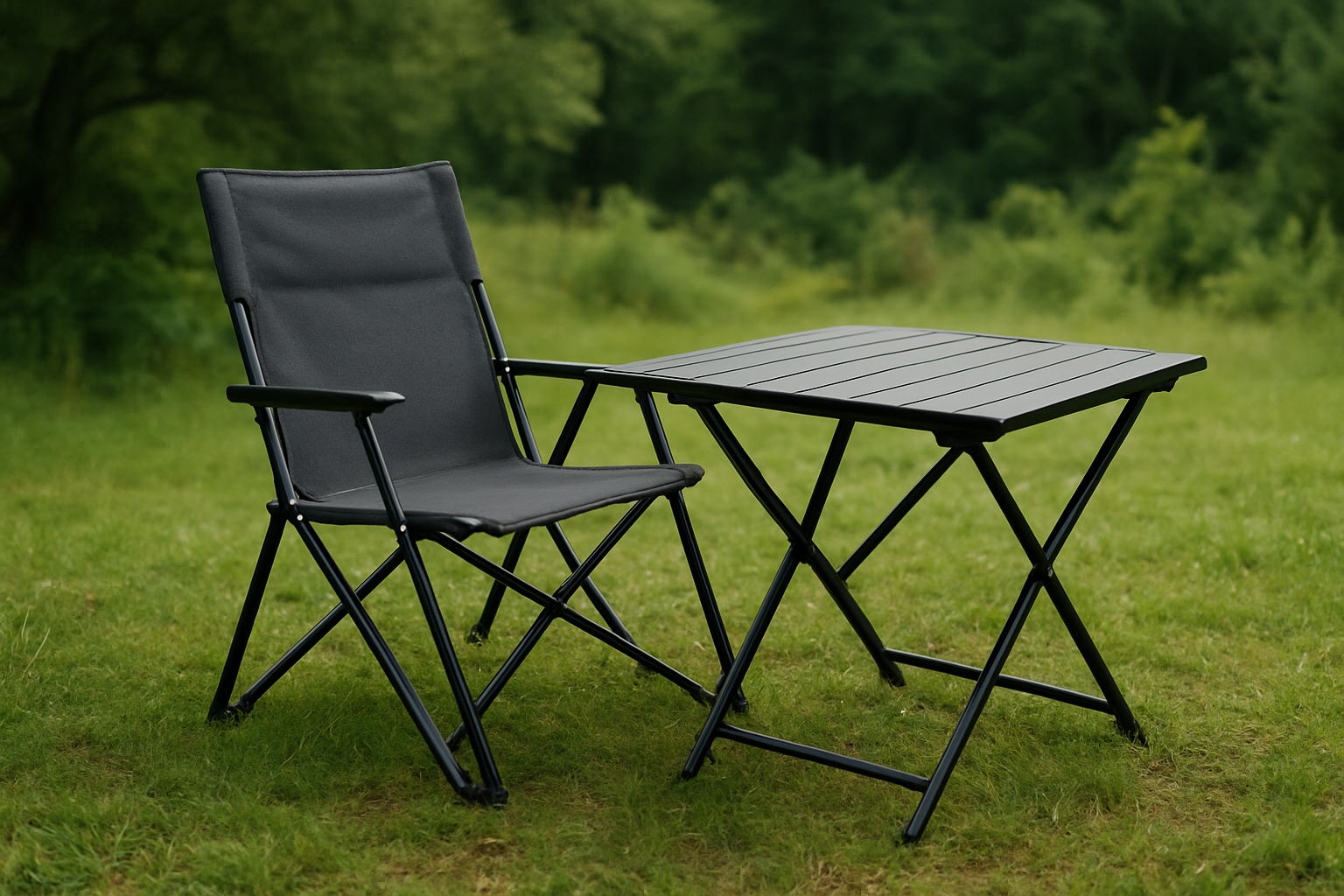
Materials dictate feel and lifespan. Aluminum frames excel for weight and corrosion resistance, ideal for beach and humid climates. Steel frames shine in heavy-duty roles and family setups where durability wins over ounces. Fabrics like 600 denier (D) polyester resist abrasion, while breathable mesh panels reduce sweat on warm nights. Powder coatings protect metal, but rinse gear after salty trips to extend life.
Care is simple: shake out sand, wipe down with mild soap, and let everything dry fully before packing. Check fasteners every few trips, especially on folding hinges and leg crossbars that handle the most stress. Replace rubber feet when they crack to maintain grip on decks and rocks. With light maintenance, quality chair and table pairs last many seasons, cutting waste and saving money.
Want a shortcut to long-lasting choices? Camper Loadouts scoring includes material durability, fastener quality, and field repairability. By weighing those against your desired pack volume and setup time, you get reliable picks for how to choose the right camping chair and table without trial and error.
The Camper Loadouts Edge: From Numbers to Nightly Comfort
Many campers buy on impulse and end up with a wobbly table or a chair that sits too low for eating. That is why Camper Loadouts focuses on measured seat-to-table geometry, stability scoring, and true pack volume rather than marketing claims. The result is a coherent kit that feels like a living room outside, not a compromise with a view. Our guides show exactly how each chair matches specific tables and organizers to create one smooth system.
We also publish chair comparisons that may cover angler-relevant factors such as swivel resistance, foot width on mud and sand, and side table reach distances for quick access. For glampers, we curate cohesive layouts that place side tables, lanterns with light emitting diode (LED) bulbs, and organizers where your hands naturally fall. For car campers, we add ergonomic upgrades like lumbar cushions and adjustable armrests. With data behind every recommendation, you can pick once and relax often.
If you are ready to stop rushing meals and start savoring them, use the pairing method, then browse Camper Loadouts chair and table pairing guides. You will see your measurements reflected in the recommendations, and your time on the trail and by the fire will feel better for it. That is camp comfort, engineered and earned.
Quick Reference: Measurements to Take Before You Buy
Keep this list handy. A measuring tape and two numbers will beat hours of browsing. Write them down now, then compare against any chair and table you consider. When the geometry matches your body, even a budget setup feels premium. And if you want to skip the math, Camper Loadouts has calculators and presets aligned to typical heights and activities.
- Seated elbow height in inches and centimeters
- Popliteal height (floor to back of knee) in inches and centimeters
- Desired use: dining, lounging, or fishing
- Typical terrain: sand, dirt, gravel, or decking
- Trunk opening width and depth in inches and centimeters
- Preferred maximum setup time per pair
Combine these with the tables above and you will narrow choices quickly. Your shortlist should include only pairs that hit your elbow and knee angles, meet your pack volume target, and fit your time budget. That is the Camper Loadouts approach: a cohesive setup where each piece supports the others for stability, comfort, and pack efficiency.
Your camp should be a place to settle in, share stories, and linger. When seat and table heights align, wobbles vanish and meals slow down. Now you know how to choose the right camping chair and table without guesswork - by measuring, pairing, and verifying stability before you buy.
Conclusion
Comfort at camp is not luck; it is the repeatable result of matching human measurements to stable, well-chosen furniture.
Imagine every meal steady and every fireside hour effortless because your chair, table, and organizers work in harmony. In the next 12 months, more campers will replace mismatched pieces with cohesive, data-backed setups they actually love to use.
With your measurements in hand, you already know how to choose the right camping chair and table. What pairing will you test first on your next night under the stars?
Additional Resources
Explore these authoritative resources to dive deeper into how to choose the right camping chair and table.
- The Best Camping Chairs of 2025 | Tested & Rated
- 12 Best Camping Chairs of 2025 (Field-Tested) - Treeline Review
Match Chairs and Tables With Camper Loadouts
Use chair and table pairing guides from Camper Loadouts to get data-driven matches that boost comfort, stability, and pack efficiency for outdoor enthusiasts and glampers.
Related Articles


